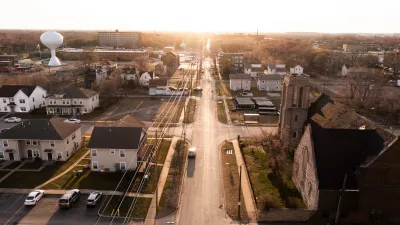Counter to the predictions of mass chaos due to inexperienced riders being unleashed on city streets, the launch of bike-sharing in New York and elsewhere increases safety for all cyclists.
"It took only a few days for reports of the first cycling accident involving New York’s new bike sharing program to begin circulating. But experts and growing experience from bike sharing programs in other cities make clear that bicycling can be a safe mode of transportation, and the presence of a bike sharing program is a boon to the safety of all bicyclists," reports Sophie Egan.
“A number of studies have looked at increased biking, and the result is that the more people bike in a community, the less likely they are to collide with motorists,” said David Vlahov, the dean of nursing at the University of California, San Francisco. “It is likely due to motorists becoming more aware or expecting more to be riding bicycles.”
"Transportation departments across the United States have begun to respond with creative improvements for safer roadways," Egan explains. "The National Association of City Transportation Officials has developed an exhaustive urban bikeway design guide based on a worldwide literature review, experiences from its 22 member cities and collaboration with traffic engineers, city planners and academic researchers. The guide informed new citywide bike safety plans for Seattle and San Francisco."
"Recommendations include protected or buffered bike lanes, colored pavement, shared lane markings, special intersection signals and detectors for bicycles, and bike boxes, the painted areas before intersections that allow bicyclists to get in front of the line of cars at a red light," she adds. "In addition to infrastructure, education and policy play a role."
Not only is such infrastructure good for cyclists, it improves the safety of all road users.
FULL STORY: Bike Sharing Can Mean Safer Biking

Alabama: Trump Terminates Settlements for Black Communities Harmed By Raw Sewage
Trump deemed the landmark civil rights agreement “illegal DEI and environmental justice policy.”

Planetizen Federal Action Tracker
A weekly monitor of how Trump’s orders and actions are impacting planners and planning in America.

The 120 Year Old Tiny Home Villages That Sheltered San Francisco’s Earthquake Refugees
More than a century ago, San Francisco mobilized to house thousands of residents displaced by the 1906 earthquake. Could their strategy offer a model for the present?

In Both Crashes and Crime, Public Transportation is Far Safer than Driving
Contrary to popular assumptions, public transportation has far lower crash and crime rates than automobile travel. For safer communities, improve and encourage transit travel.

Report: Zoning Reforms Should Complement Nashville’s Ambitious Transit Plan
Without reform, restrictive zoning codes will limit the impact of the city’s planned transit expansion and could exclude some of the residents who depend on transit the most.

Judge Orders Release of Frozen IRA, IIJA Funding
The decision is a victory for environmental groups who charged that freezing funds for critical infrastructure and disaster response programs caused “real and irreparable harm” to communities.
Urban Design for Planners 1: Software Tools
This six-course series explores essential urban design concepts using open source software and equips planners with the tools they need to participate fully in the urban design process.
Planning for Universal Design
Learn the tools for implementing Universal Design in planning regulations.
Clanton & Associates, Inc.
Jessamine County Fiscal Court
Institute for Housing and Urban Development Studies (IHS)
City of Grandview
Harvard GSD Executive Education
Toledo-Lucas County Plan Commissions
Salt Lake City
NYU Wagner Graduate School of Public Service




























